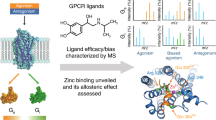Abstract
A hypothesis concerning two distinct classes of amino acid residues in some regulatory binding sites is proposed. The “affinity residues” are those that are unable to transduce the ligand information signal but are responsible for overcoming the barrier for the attachment of a ligand to its binding site while the “effector residues” transfer the binding signal to the other functional part of the protein, which then undergoes a non-equilibrium energetic cycle induced by interaction with the ligand.
As an example, the purine nucleotide inhibition of H+ transport through the uncoupling protein of brown adipose tissue mitochondria is discussed; there is a concentration range in which the nucleotide is bound but does not inhibit H+ transport. This is interpreted in terms of inaccessibility of the effector residues inducing H+ transport inhibition below a certain threshold concentration.
Similar content being viewed by others
References
Aquila H, Link T, Klingenberg M (1985) The uncoupling protein from brown fat mitochondria is related to the mitochondrial ADP/ATP carrier. Analysis of sequence homologies and of folding of the protein in the membrane. EMBO J 4:2369–2376
Ariëns EJ, Beld AJ, deMiranda JFR, Simonis AM (1979) The pharmacon receptor — effector concept: A basis for understanding the transmission of information in biological systems. In: O'Brien RDO (ed) The receptors, a comprehensive treatise, Vol 1. Plenum Press, New York, pp 33–91
Blumenfeld LA (1976) The physical aspects of enzyme functioning. J Theor Biol 58:269–284
Blumenfeld LA (1981) Problems of biological physics. Springer, Berlin Heidelberg New York
Citri N (1973) Conformational adaptability in enzymes. Adv Enzymol 37:397–648
Cooper A, Dryden DTF (1984) Allostery without conformational change. A plausible model. Eur Biophys J 11:103–109
Daggett SG, Schuster SM (1984) An information theoretic model for allosteric enzymes: Theory. Appl Phys Commun 4:187–206
Dohlman EG, Caron MG, Lefkowitz RJ (1987) A family of receptors coupled to guanine nucleotide regulatory proteins. Biochemistry 26:2657–2264
Fersht A (1977) Enzyme structure and mechanism. WA Freemen, San Francisco
Fersht AR, Leatherbarrow RJ, Wells TNC (1986) Binding energy and catalysis: a lesson from protein engineering of the tyrosyl-tRNA synthetase. Trends Biochem Sci 11:321–325
Heaton GM, Nicholls DG (1977) The structural specificity of the nucleotide binding and the reversible nature of the inhibition of proton conductance induced by bound nucleotides in brown adipose tissue mitochondria. Biochem Soc Trans 5:210–212
Hill TL (1977) Free energy transduction in biology. Academic Press, New York
Hille B (1984) Ionic channels of excitable membranes. Sinauer, Sunderland, USA
Jencks WP (1975) Binding energy, specificity, and enzymic catalysis: The Circe effect. Adv Enzymol 43:219–410
Karplus M, McCammon JA (1983) Dynamics of proteins: Elements and function. Annu Rev Biochem 53:263–300
Kenakin TP (1984) The classification of drugs and drug receptors in isolated tissues. Pharmacol Rev 36:165–222
Kenakin TP (1985) The quantification of relative efficacy of agonists. J Pharmacol Methods 13:281–308
Klingenberg M (1984) Characteristic of the uncoupling protein from brown fat mitochondria. Biochem Soc Trans 12:390–393
Klingenberg M (1986) Fluorescent nucleotide analogs as active site probes for the ADP/ATP carrier and the uncoupling protein. Methods Enzymol 125:618–630
Klingenberg M, Winkler E (1985) The reconstituted isolated uncoupling protein from brown fat mitochondria is a membrane potential driven H+-translocator. EMBO J 4:3087–3092
Kopecký J, Guerrieri F, Ježek P, Drahota Z, Houštěk J (1984) Molecular mechanism of uncoupling in brown adipose tissue mitochondria. The nonidentity of proton and chloride conducting pathways. FEBS Lett 170:186–190
Kopecký J, Ježek P, Drahota Z, Houštěk J (1987) Control of uncoupling protein in brown fat mitochondria by purine nucleotides. Chemical modification by diazobenzene sulfonate. Eur J Biochem 164:687–694
Koshland DE, Neet KE (1968) The catalytic and regulatory properties of enzymes. Annu Rev Biochem 37:359–410
Lin CS, Klingenberg M (1982) Characteristic of the isolated purine nucleotide binding protein from brown fat mitochondria. Biochemistry 21:2950–2956
Maelicke A (ed) (1986) Structure and function of the nicotinic acetylcholine receptor. Springer, Berlin Heidelberg New York
Martonosi AN (ed) (1985) The enzymes of biological membranes. Vol 3: Membrane transport. Plenum Press, New York
Mazat JP (1977) Double-site enzymes and squatting. A study of the regulation by one or several ligands binding at two different classes of site. J Theor Biol 68:365–383
McQuarrie DA (1976) Statistical mechanics. Harper & Row, New York
Nicholls DG, Cannon B, Grav HJ, Lindberg O (1974) Energy dissipation in nonshivering thermogenesis. In: Ernster L, Estabrook R, Slater EC (ed) Dynamics of energy transducing membranes. Elsevier, Amsterdam, pp 529–530
Rappaport HP (1976) An analysis of the binding of related ligands. J Theor Biol 58:253–268
Schuster D, Levitzki A (eds) (1980) Cellular receptors for hormones and neurotransmitters. John Wiley & Sons, New York
Strieleman PJ, Schalinske KL, Shrago E (1985) Fatty acid activation of the reconstituted brown adipose tissue mitochondrial uncoupling protein. J Biol Chem 260:13402–13405
Vignais PV, Lunardi J (1985) Chemical probes of the mitochondrial ATP synthesis and translocation. Annu Rev Biochem 54:977–1014
Weber G (1986) Phenomenological description of the association of protein subunits subjected to conformational drift. Effect of dilution and of hydrostatic pressure. Biochemistry 25:3626–3631
Welch GR (1984) Biochemical dynamics in organized states: A holistic approach. In: Cornish-Bowden A, Ricard J (eds) Dynamics of biochemical systems. Plenum Press, New York, pp 85–101
Welch GR (ed) (1986) The fluctuating enzyme: Toward the secret of nature's catalysis. John Wiley & Sons, London
Xu GJ, Weber G (1982) Dynamics and time-averaged chemical potential of proteins. Importance of oligomer association. Proc Natl Acad Sci USA 79:5268–5271
Author information
Authors and Affiliations
Rights and permissions
About this article
Cite this article
Ježek, P., Houštěk, J., Kotyk, A. et al. Distinct affinity and effector residues in the binding site for a regulatory ligand. Eur Biophys J 16, 101–108 (1988). https://doi.org/10.1007/BF00255519
Received:
Accepted:
Issue Date:
DOI: https://doi.org/10.1007/BF00255519




